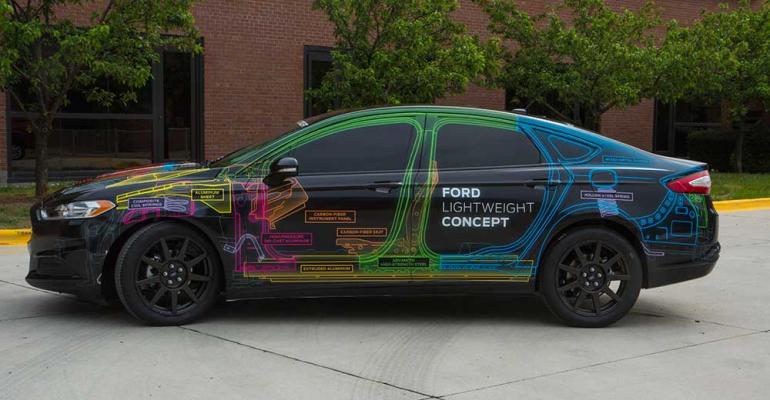DEARBORN, MI – Ford shook up the industry when it rolled out its upcoming aluminum-intensive ’15 F-150 pickup at the North American International Auto Show in January.
Now it is moving to take its mass-reduction movement even further with the Ford Lightweight Concept Car it will show off this week at the TechShop conference in San Francisco.
“Whether lightweight steel alloys, aluminum, magnesium, composites or carbon fiber, we’ve been looking at the challenges of bringing these into mass production and making them affordable,” Randy Visintainer, director-Ford Research and Innovation, says at a media event here.
The ’15 F-150, due in the fourth quarter, is 700 lbs. (317 kg) lighter than its predecessor thanks to extensive use of aluminum. It will be one of the first mass-produced vehicles to utilize aluminum to such an extent.
The weight loss is expected to result in better fuel economy and reduced carbon-dioxide emissions without sacrificing the capability of the pickup.
Visintainer says the automaker began intensive research into lightweighting in 2001 following a request by Chairman Bill Ford, who asked his engineering team to determine whether climate change was real and if CO2 emissions were the primary cause.
“We told Bill it is real and our industry and Ford are part of the problem, so we have to be part of the solution,” he says. “People in our industry were in a denial phase.”
Ford engineered a 3-step solution to the problem. First was developing boosted downsized engine technology. Next came aggressive lightweighting, followed by alternative powertrains.
The Ford GT supercar, which launched in 2004, was the first foray into lightweighting. The GT featured an aluminum-spaceframe chassis, carbon-fiber inner rear deck and stamped aluminum panels.
“The lightweighting delivered the technology around advanced materials and manufacturing technology,” says Matt Zaluzec, Ford Technical Leader-Global Materials and Manufacturing Research. “This also was the start of the mixed-material vehicle. It’s about choosing the right material for that particular product.”
Prior to the Ford GT, engineers gained valuable experience working on projects such as the Aluminum Intensive Vehicle program in 1992 followed by development of the Jaguar XJ in 2003.
Fusion-Based Concept 25% Lighter
The culmination of knowledge fueled the creation of the Lightweight Concept Car, which is a ’13 Ford Fusion that has been aggressively fitted with advanced materials making it 25% lighter than the production car, or about the same weight as a Fiesta B-car.
To reduce weight, nearly every component of the Fusion was made lighter through the use of a variety of materials.
Lightweight components used on the concept include aluminum brake rotors coated with steel; composite and hollow steel coil springs; carbon-fiber and interior components; a polycarbonate rear window and hollow steel stabilizer bars.
The drastic weight reduction allowed engineers to outfit the Fusion with a 1.0L 3-cyl. EcoBoost engine, which further reduces mass.
Most of the substitution materials cost far more than their traditional counterparts, but the goal of the Lightweight Concept Car was not to design a production-feasible vehicle, but rather explore possibilities for future lightweighting opportunities.
“This is technology available in the near term,” Zaluzec says. “It doesn’t mean we can turn a switch on and produce this vehicle tomorrow. It means the technology is not a leap of faith, and we’re working with the industry to help them grow that technology.”
Ford currently is working with supplier partner Samsung on next-generation battery technology that will pair a small lithium-ion pack with a traditional lead-acid unit.
The dual-battery configuration will allow for more efficient stop/start systems that will be able to capture energy from regenerative braking systems for increased fuel savings.
“We are currently expanding our Auto Start-Stop technology across 70% of our lineup, and this dual-battery system has the potential to bring even more levels of hybridization to our vehicles,” says Ted Miller, senior manager-Energy Storage Strategy and Research. “Although still in research, this type of battery could provide a near-term solution for greater carbon-dioxide reduction.”





